There are two primary types of hydroceles:
Noncommunicating hydrocele: In this type, the sac seals normally, but the fluid within it is not reabsorbed by the body.
Communicating hydrocele: The sac remains unsealed, maintaining a connection to the abdomen, leading to scrotal swelling.
Potential side effects of hydrocele surgery include infection, blood clots, recurrence of the hydrocele, injury to nearby structures, and swelling with bruising.
Various types of hydroceles exist, including:
- Primary Hydrocele
- Secondary Hydrocele
- Infantile hydrocele
- Congenital Hydrocele
- Encysted hydrocele
- Funicular hydrocele
Treatment involves diagnosis and procedure steps:
Diagnosis:
At Pilot Heal, our skilled doctors use modern equipment to diagnose hydroceles. A physical examination is conducted to identify the underlying cause. The scrotum's tenderness is assessed by applying gentle pressure, and light transmission through the scrotum indicates the presence of fluid. Coughing may also be induced to assess scrotal discomfort. Diagnostic tests like blood tests and urine cultures might be recommended to determine the root cause.
Procedure:
Open hydrocelectomy, a surgical procedure typically performed under general anesthesia, involves making an incision in the scrotum or groin. Fluid is then suctioned out, the communication between the abdominal cavity and scrotum is sealed, and the hydrocele sac is removed. Sutures or surgical strips are used to close the incisions.
Please note that medical practices and information may have evolved since my last knowledge update. It's advisable to consult with medical professionals or trusted sources for the most current and accurate information.

